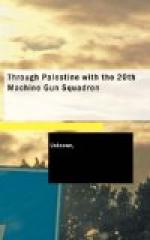A few days were necessarily spent in the Wadi Nueiame in exercising the horses and becoming acclimatized to the temperature, which rarely falls below 100 deg., even at night, and is usually 120 deg. in the shade (or over) during the day. On July 7th, “No. 1” Section paraded at 19.00 and proceeded to the east of the Jordan to relieve a section of the 21st Squadron in the line. “A” Sub-section took over the emplacements in No. 3 Post, and “C” Sub-section those in No. 5 Post. The relief was completed by 23.00. The next evening, the remainder of the Squadron relieved the 21st Squadron in their camp at the Ghoraniyeh Bridge. One section only going at a time to avoid attracting attention and being shelled by the Turks, who were posted in the hills. The new camp was within 100 yards of the Jordan,[18] nearly surrounded by cliffs, the tops of which were level with the plain above. The cliffs themselves only being formed by the depression in the plain before it gives way to the lower ground in the immediate vicinity of the River Jordan and the east of it. The river at this point is actually 1,250 feet below the level of the sea!
[Illustration: Squadron Camp in the Jordan Valley. “No. 2” Section.]
On arriving in the camp, “No. 2” Section took over the machine-gun positions for the inner defences of the bridgehead. These had to be manned at night only, and were on the tops of the cliffs near the camp, commanding all the crossings of the river. Every evening just before dusk (sometimes in a severe dust storm), the four guns were taken up on the pack-mules by the gun-teams and brought back after light the next morning. “No. 3” Section was in Divisional reserve, and liable to be called on at short notice to proceed to any part of the line. It provided also all the camp fatigues.
It was soon found that summer-life in the Jordan Valley was about the limit of discomfort; only those who have been there at that season can have any idea of what it is like. If only our turn had been in the winter, when according to all accounts the weather is bearable! Needless to say that as much work as possible was done in the early morning and evening, but even this was extremely trying for all. Fortunately, water was available from a small stream just outside the camp. Rush-huts and bivouacs provided the best protection against the sun. Material for these was obtained from the banks of the Jordan, where, for a few yards on either side, there was luxurious vegetation—in striking contrast with the rest of the country; during the day men were allowed to bathe in the river.
All wheels had to be covered over during the day in order to prevent the wood shrinking; if this had not been done, very little transport could have been brought out of the valley at the end of the Brigade’s tour of duty!
There is, a little over a mile east of the Jordan, a series of low isolated hills; upon these was situated our line of defence. Each hill, fortified with barbed-wire and trenches, constituted a “post”. This line was held by Indian Infantry, the regiments of the cavalry brigade providing the patrols in “no man’s land,” which, several miles wide, was intersected by thousands of wadis (providing excellent cover for a stealthy enemy), also a certain amount of tall grass.




